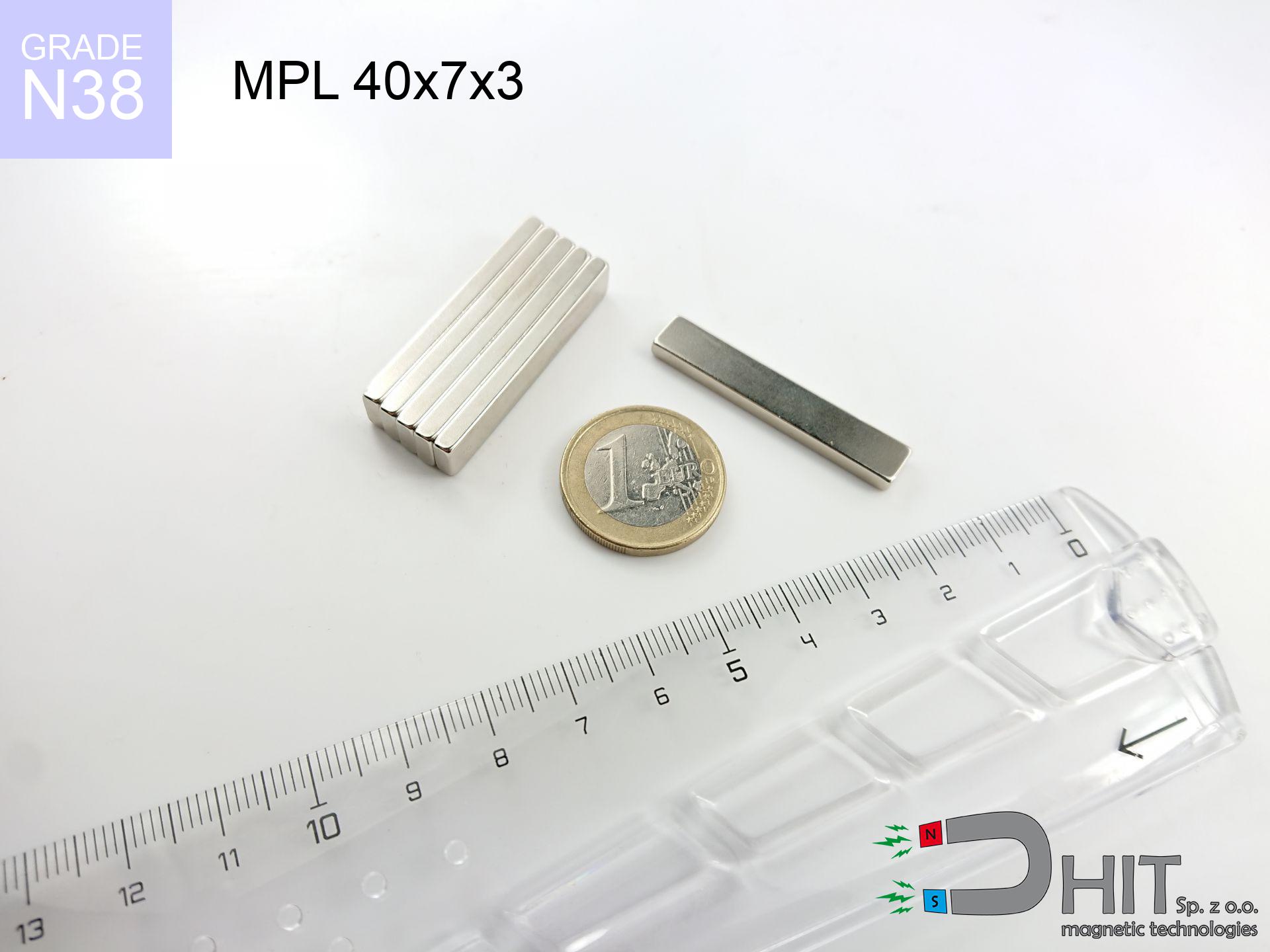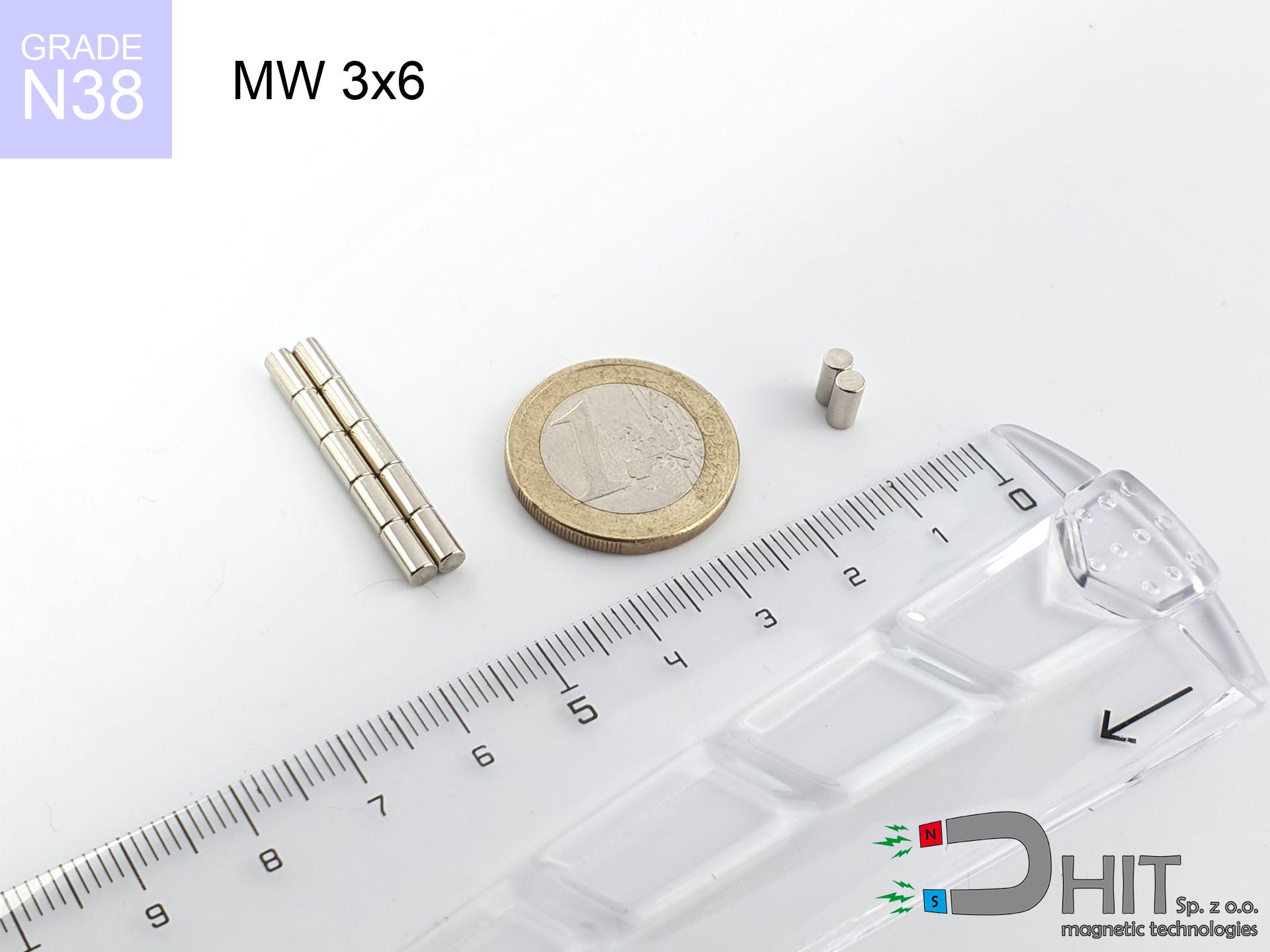MPL 40x7x3 / N38 - lamellar magnet
lamellar magnet
Catalog no 020162
GTIN: 5906301811688
length [±0,1 mm]
40 mm
Width [±0,1 mm]
7 mm
Height [±0,1 mm]
3 mm
Weight
6.3 g
Magnetization Direction
↑ axial
Load capacity
3.96 kg / 38.83 N
Magnetic Induction
284.46 mT
Coating
[NiCuNi] nickel
2.79 ZŁ with VAT / pcs + price for transport
2.27 ZŁ net + 23% VAT / pcs
bulk discounts:
Need more?Do you have purchase concerns?
Give us a call
+48 22 499 98 98
otherwise send us a note using
form
through our site.
Weight as well as form of neodymium magnets can be reviewed on our
magnetic calculator.
Same-day shipping for orders placed before 14:00.
Magnetic properties of material N38
Physical properties of sintered neodymium magnets Nd2Fe14B at 20°C
Shopping tips
Strengths and weaknesses of rare earth magnets.
Apart from their consistent magnetic energy, neodymium magnets have these key benefits:
- They virtually do not lose strength, because even after ten years the performance loss is only ~1% (based on calculations),
- They show high resistance to demagnetization induced by external disturbances,
- The use of an shiny layer of noble metals (nickel, gold, silver) causes the element to present itself better,
- Neodymium magnets deliver maximum magnetic induction on a small surface, which ensures high operational effectiveness,
- Neodymium magnets are characterized by very high magnetic induction on the magnet surface and can work (depending on the shape) even at a temperature of 230°C or more...
- Possibility of accurate modeling and adapting to concrete requirements,
- Versatile presence in modern technologies – they are used in mass storage devices, electric drive systems, medical devices, also industrial machines.
- Relatively small size with high pulling force – neodymium magnets offer high power in small dimensions, which makes them useful in compact constructions
What to avoid - cons of neodymium magnets: tips and applications.
- They are prone to damage upon heavy impacts. To avoid cracks, it is worth protecting magnets in a protective case. Such protection not only shields the magnet but also increases its resistance to damage
- NdFeB magnets demagnetize when exposed to high temperatures. After reaching 80°C, many of them experience permanent weakening of power (a factor is the shape as well as dimensions of the magnet). We offer magnets specially adapted to work at temperatures up to 230°C marked [AH], which are extremely resistant to heat
- Due to the susceptibility of magnets to corrosion in a humid environment, we recommend using waterproof magnets made of rubber, plastic or other material stable to moisture, in case of application outdoors
- We recommend casing - magnetic holder, due to difficulties in realizing threads inside the magnet and complex shapes.
- Possible danger to health – tiny shards of magnets can be dangerous, if swallowed, which becomes key in the aspect of protecting the youngest. Additionally, tiny parts of these devices can complicate diagnosis medical after entering the body.
- With budget limitations the cost of neodymium magnets can be a barrier,
Optimal lifting capacity of a neodymium magnet – what affects it?
Information about lifting capacity was determined for ideal contact conditions, assuming:
- with the contact of a sheet made of special test steel, ensuring full magnetic saturation
- whose transverse dimension equals approx. 10 mm
- characterized by even structure
- under conditions of no distance (surface-to-surface)
- during pulling in a direction vertical to the plane
- at temperature approx. 20 degrees Celsius
Practical aspects of lifting capacity – factors
Real force impacted by working environment parameters, mainly (from priority):
- Clearance – the presence of any layer (paint, tape, air) interrupts the magnetic circuit, which lowers capacity rapidly (even by 50% at 0.5 mm).
- Load vector – maximum parameter is available only during perpendicular pulling. The force required to slide of the magnet along the plate is usually many times smaller (approx. 1/5 of the lifting capacity).
- Wall thickness – the thinner the sheet, the weaker the hold. Part of the magnetic field penetrates through instead of converting into lifting capacity.
- Material composition – not every steel attracts identically. Alloy additives worsen the interaction with the magnet.
- Surface condition – ground elements guarantee perfect abutment, which improves force. Uneven metal weaken the grip.
- Thermal factor – high temperature weakens pulling force. Too high temperature can permanently damage the magnet.
* Lifting capacity was determined with the use of a steel plate with a smooth surface of suitable thickness (min. 20 mm), under perpendicular detachment force, however under parallel forces the lifting capacity is smaller. Moreover, even a small distance {between} the magnet’s surface and the plate lowers the load capacity.
Warnings
Threat to electronics
Avoid bringing magnets close to a purse, computer, or screen. The magnetic field can destroy these devices and erase data from cards.
Heat warning
Avoid heat. Neodymium magnets are susceptible to heat. If you require resistance above 80°C, ask us about special high-temperature series (H, SH, UH).
Fragile material
Despite the nickel coating, the material is brittle and cannot withstand shocks. Avoid impacts, as the magnet may shatter into sharp, dangerous pieces.
Choking Hazard
Strictly keep magnets out of reach of children. Choking hazard is significant, and the consequences of magnets connecting inside the body are tragic.
Life threat
Medical warning: Strong magnets can deactivate pacemakers and defibrillators. Do not approach if you have medical devices.
Precision electronics
A powerful magnetic field interferes with the operation of compasses in smartphones and GPS navigation. Do not bring magnets close to a device to avoid breaking the sensors.
Do not underestimate power
Before use, check safety instructions. Sudden snapping can break the magnet or injure your hand. Think ahead.
Allergy Warning
Certain individuals have a sensitization to nickel, which is the typical protective layer for neodymium magnets. Prolonged contact might lead to an allergic reaction. We recommend wear safety gloves.
Bone fractures
Pinching hazard: The pulling power is so immense that it can result in hematomas, pinching, and even bone fractures. Use thick gloves.
Fire risk
Powder created during grinding of magnets is flammable. Avoid drilling into magnets without proper cooling and knowledge.
Security!
Need more info? Read our article: Are neodymium magnets dangerous?




![SM 25x400 [2xM8] / N42 - magnetic separator SM 25x400 [2xM8] / N42 - magnetic separator](https://cdn3.dhit.pl/graphics/products/sm-25x400-2xm8-daj.jpg)

![SM 32x100 [2xM8] / N52 - magnetic separator SM 32x100 [2xM8] / N52 - magnetic separator](https://cdn3.dhit.pl/graphics/products/sm-32x100-2xm8-war.jpg)
![SM 18x125 [2xM5] / N42 - magnetic separator SM 18x125 [2xM5] / N42 - magnetic separator](https://cdn3.dhit.pl/graphics/products/sm-18x125-2xm5-cij.jpg)

